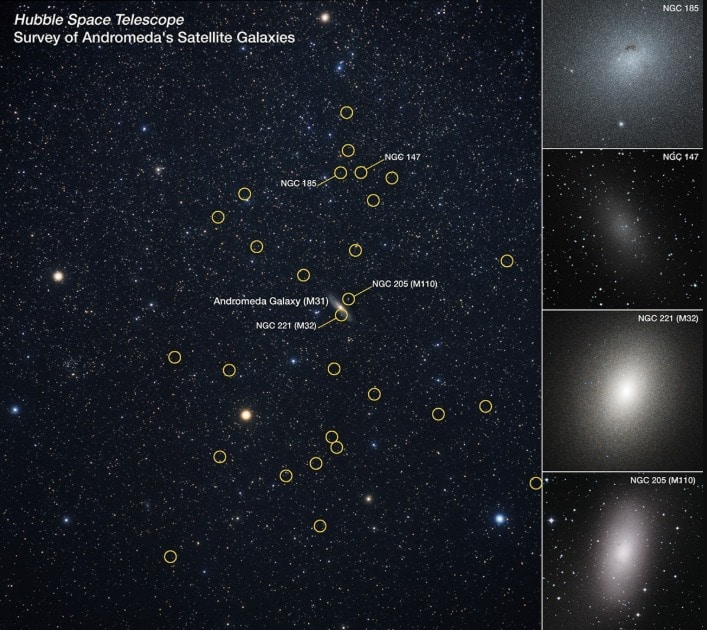



NASA’s Hubble Space Telescope reveals surprising details about Andromeda’s satellite galaxies, offering fresh insights into the galaxy’s evolution and structure.
The Andromeda galaxy, located 2.5 million light-years away, is visible to the naked eye. It appears as a faint, spindle-shaped object about the size of the full Moon. However, what backyard astronomers cannot see is a swarm of nearly three dozen small galaxies orbiting it like bees around a hive.
NASA’s Hubble Space Telescope has been studying these satellite galaxies in remarkable detail. Using data from over 1,000 Hubble orbits, researchers built a 3D map of Andromeda’s satellite system. They also analysed how efficiently these galaxies formed stars over billions of years. The findings, published in The Astrophysical Journal, suggest that Andromeda’s history has been more turbulent than the Milky Way’s.
Unlike our galaxy, which has had a calmer past, Andromeda likely experienced a major collision with another galaxy a few billion years ago. This event, along with its larger mass—possibly twice that of the Milky Way—may explain why Andromeda has so many diverse satellite galaxies.
Unravelling Andromeda’s Galactic Influence
Studying the Milky Way’s satellite system in detail is difficult because we live inside it. Other massive galaxies are too far away to observe their satellite systems closely. Andromeda, however, provides a unique opportunity for astronomers to understand how small galaxies evolve under the influence of a massive galaxy.
 This is a wide-angle view of the distribution of known satellite galaxies orbiting the large Andromeda galaxy (M31), located 2.5 million light-years away. The Hubble Space Telescope was used to study the entire population of 36 mini-galaxies circled in yellow. Andromeda is the bright spindle-shaped object at image center. All the dwarf galaxies seem to be confined to a plane, all orbiting in the same direction. The wide view is from ground-based photography. Hubble's optical stability, clarity, and efficiency made this ambitious survey possible. Hubble close up snapshots of four dwarf galaxies are on image right. The most prominent dwarf galaxy is M32 (NGC 221), a compact ellipsoidal galaxy that might be the remnant core of a larger galaxy that collided with Andromeda a few billion years ago. (Image: NASA)
This is a wide-angle view of the distribution of known satellite galaxies orbiting the large Andromeda galaxy (M31), located 2.5 million light-years away. The Hubble Space Telescope was used to study the entire population of 36 mini-galaxies circled in yellow. Andromeda is the bright spindle-shaped object at image center. All the dwarf galaxies seem to be confined to a plane, all orbiting in the same direction. The wide view is from ground-based photography. Hubble's optical stability, clarity, and efficiency made this ambitious survey possible. Hubble close up snapshots of four dwarf galaxies are on image right. The most prominent dwarf galaxy is M32 (NGC 221), a compact ellipsoidal galaxy that might be the remnant core of a larger galaxy that collided with Andromeda a few billion years ago. (Image: NASA)
"The ability of these satellites to form stars depends on their mass and distance from Andromeda," said lead author Alessandro Savino from the University of California, Berkeley. This suggests that Andromeda’s gravitational pull affects the growth of its satellite galaxies.
Researchers also noticed an unexpected pattern. Around half of Andromeda’s satellite galaxies seem to orbit in the same plane and direction. "That was a complete surprise, and we still don’t understand why," said principal investigator Daniel Weisz.
One of the brightest of these satellites is Messier 32 (M32). Scientists believe it might be the remnant core of a larger galaxy that collided with Andromeda. Over time, it lost much of its gas and stars but continued orbiting its larger neighbour. Despite its older stars, M32 appears to have experienced a sudden burst of star formation a few billion years ago.
A New Perspective on Galaxy Evolution
Another key discovery is that some of Andromeda’s dwarf galaxies continued forming stars for much longer than expected. While most galaxies stop forming stars early on, these dwarfs maintained a slow but steady process over time.
"Star formation continued much later than we expected," said Savino. "This isn’t something computer simulations predicted, and we don’t yet know why."
Astronomers are now working on tracking the precise motions of these dwarf galaxies. In the next five years, NASA’s Hubble or James Webb Space Telescope will take new observations. These will help scientists reconstruct the movements of Andromeda’s entire ecosystem over billions of years.
"The way galaxies come together shapes their history," said Weisz. "Andromeda’s story is proving to be more complex than we ever imagined."
Discover the latest Business News, Sensex, and Nifty updates. Obtain Personal Finance insights, tax queries, and expert opinions on Moneycontrol or download the Moneycontrol App to stay updated!
Find the best of Al News in one place, specially curated for you every weekend.
Stay on top of the latest tech trends and biggest startup news.